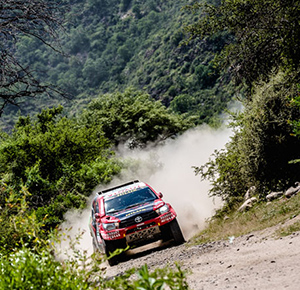DAKAR RALLY
ABOUT DAKAR RALLY
WHAT’S THE DAKAR RALLY
-
Racing across undeveloped terrain such as mountain passes, mud and deserts, the Dakar Rally is the most famous and toughest rally raid in the world. Covering over 9,000km in two weeks, drivers and their cars are pushed to the limit, testing their technique, mental/physical strength, mechanic skill and experience, driving upwards of and sometimes over 900km a day. Due to the toughness of the rally, it is said that “all drivers who complete the race are winners.” This toughness is epitomized by the fact that on average, more than half of the cars that begin the race, fail to finish it. Pitting the drivers, who come from over 50 countries, and their cars against the elements, the rally draws around 4.4 million spectators with 70 television networks broadcasting worldwide.
-

TOYOTA’S HISTORY
IN THE RACE
Toyota has participated in the race since the beginning in 1979, with 13 of the 74 vehicles that finished being Toyota vehicles. Due to cars in the production category of the race having harsh modification restrictions put upon them, their basic performance is incredibly important. Toyota’s sturdy reliability has therefore made them a favorite for privateers in the race, with many using Toyota-made vehicles. For instance in the 2016 race, 42.4% of the vehicles that finished were Toyotas.
TOYOTA GAZOO Racing South Africa first entered the Toyota Hilux in 2012 (under the Imperial Toyota name) where it came 3rd and 10th, then 2nd in 2013, 4th in 2014, 2nd in 2015 and 3rd, 5th, and 11th in 2016 (under the TOYOTA GAZOO Racing South Africa name for the first time.)
Team Land Cruiser Toyota Auto Body have been entering their Land Cruiser ever year in to the rally since 1995 (under the Team Araco name until 2004.) In the 21 years since they have entered into the race with Land Cruiser 80 series, Land Cruiser 100 series, and Land Cruiser 200 series and have enjoyed massive success, winning 15 times out of 21.
HISTORY OF THE DAKAR RALLY
Thierry Sabine founded the first Dakar Rally in 1978, originally a race across the Sahara Desert, competitors could compete in any kind of vehicle as long as it had an engine and wheels. Sabine was inspired to create the race after he found himself lost in the desert, in a separate race the year before. The following year in 1979, the Dakar Rally began proper with a three-week-long race beginning in Paris and ending in Dakar. The rally was officially certified by the FIA (Fédération Internationale de l'Automobile) in 1981 and has henceforth established itself in the world of motorsports.
The race continued in North Africa until 2008 when the rally was cancelled due to safety concerns. This acted as the catalyst to move the rally to South America which held its first race in 2009. The location may be different but the name and spirit of the event remain unchanged.